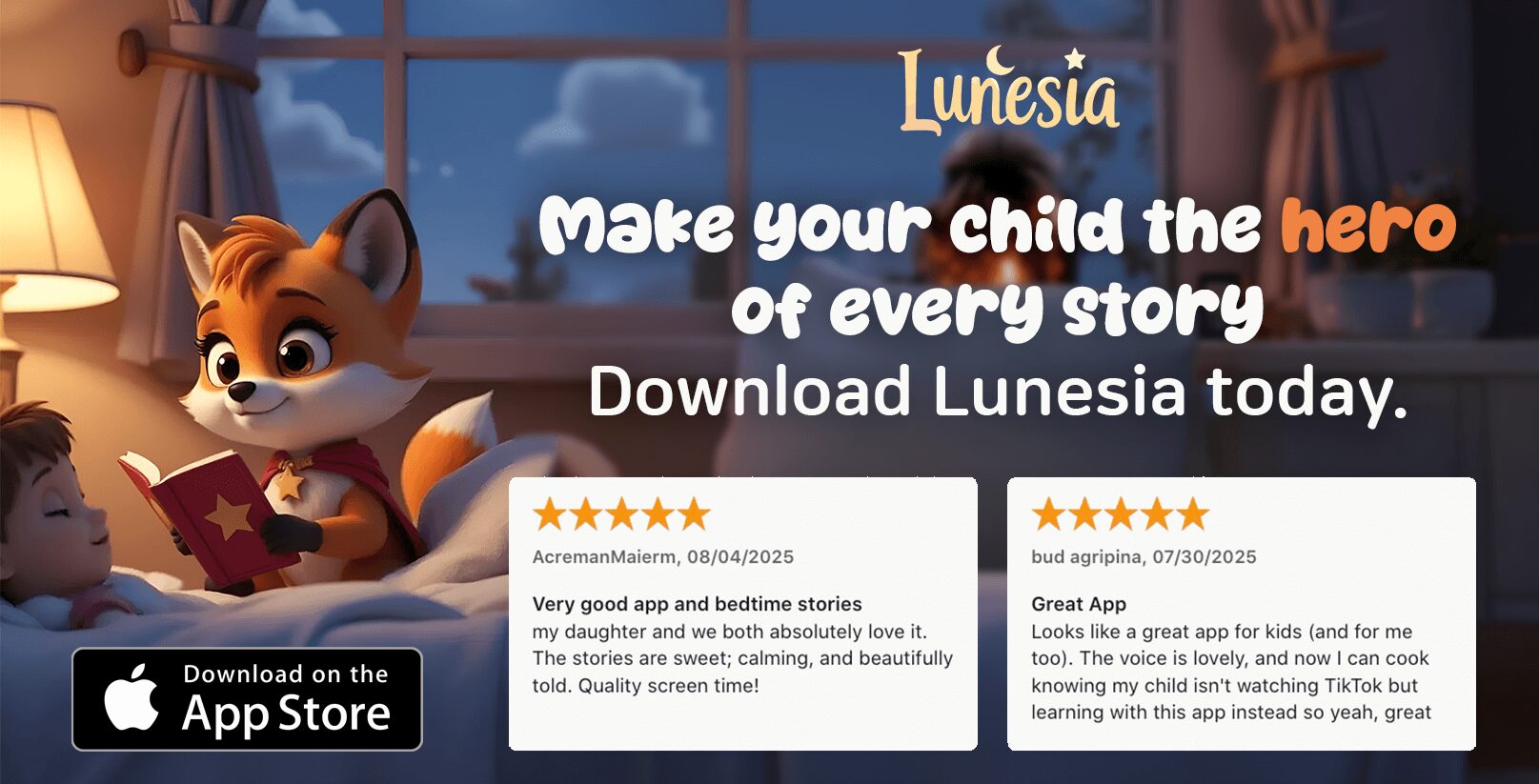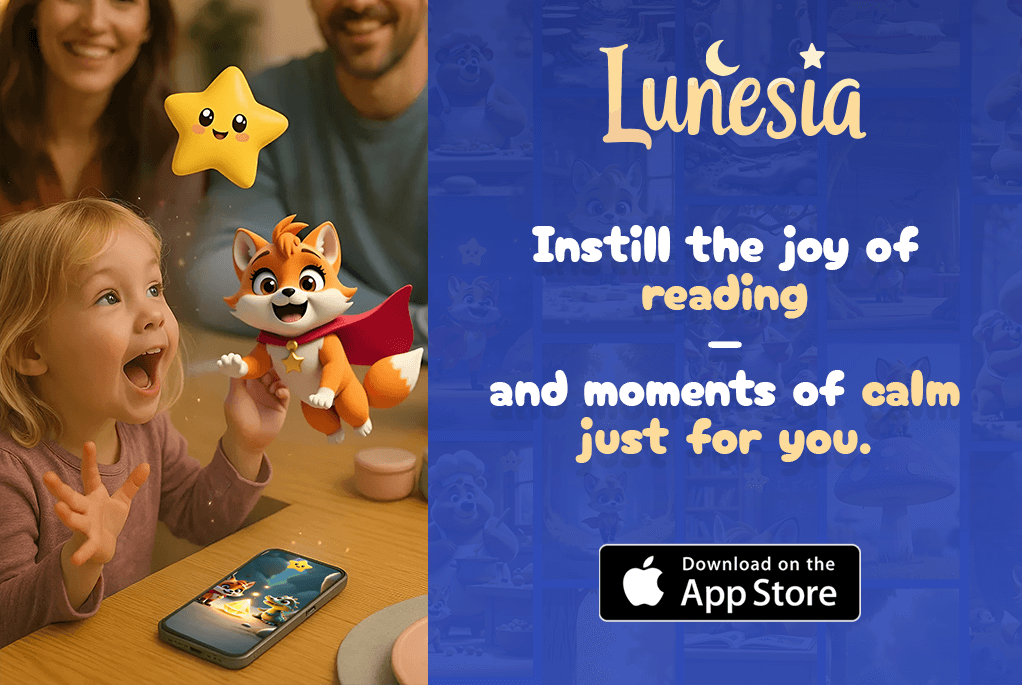As a parent, choosing the right game for your child can be a daunting task, especially with the numerous options available today. At 5 years old, children are beginning to explore the world around them, and the right games can play a significant role in their cognitive, social, and emotional development.
Dr. Puji Jonnalagadda, a board-certified developmental-behavioral pediatrician, notes that “play is integral for child development, and games facilitate play at all ages.” This is a crucial age where children start to engage in more elaborate and back-and-forth play, making the choice of game even more important.
In this article, we’ll explore the engagement and learning benefits of Lunesia compared to popular kids’ games, examining factors such as physical interaction and expert recommendations to help you make an informed decision for your child’s specific needs.
Understanding What Makes Games Engaging for 5-Year-Olds
Engaging games for 5-year-olds requires understanding their developmental stage and what captures their attention. At this age, children are beginning to explore their surroundings more actively, and their play preferences are significantly influenced by their developmental milestones.
Developmental Milestones of 5-Year-Olds
At five years old, children are achieving several developmental milestones. They are improving their fine motor skills, enhancing their cognitive abilities, and developing socially.Games that cater to these milestonescan significantly enhance their engagement. For instance, activities that involve coloring or simple crafts can help improve their fine motor skills, while games that involve problem-solving can enhance their cognitive abilities. You can explore more about how games like Lunesia support developmental milestones by visiting their website athttps://lunesia.app/.
| Developmental Area | Milestones | Engaging Game Elements |
|---|---|---|
| Fine Motor Skills | Improved dexterity, ability to use tools | Coloring, simple crafts |
| Cognitive Abilities | Problem-solving, memory enhancement | Puzzles, memory games |
| Social Development | Cooperation, sharing | Multiplayer games, cooperative play |
Key Elements That Capture a 5-Year-Old’s Attention
So, what makes a game engaging for a 5-year-old? Games that incorporatebright colors,familiar characters, andsimple rulestend to capture their attention. Immediate feedback is also crucial, as it keeps the child engaged and motivated. Moreover, activities that allow for some physical movement are more engaging for this age group, as they typically have high energy levels. As noted by child development experts, “Games that offer a balance of predictability and surprise tend to be most engaging, providing both comfort and excitement.”
Incorporating these elements into a game can make it more appealing to 5-year-olds. For example, a game that involves familiar characters from their favorite shows or movies can create an immediate connection. Additionally, games that allow for creative expression or storytelling can capture a child’s imagination and extend engagement beyond the structured game itself.
Introducing Lunesia: A New Gaming Experience
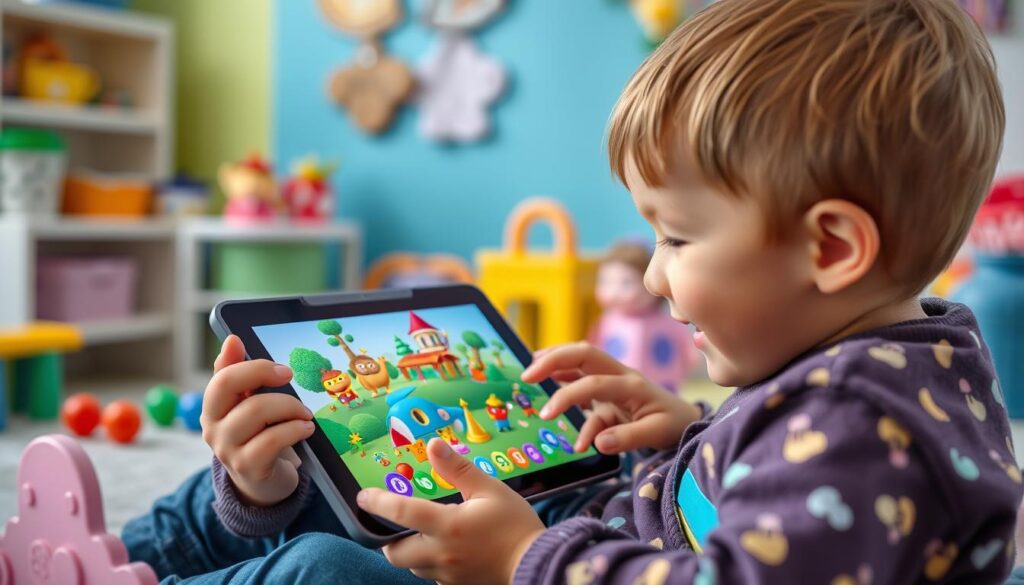
As a parent, you’re always on the lookout for games that not only entertain your child but also provide a valuable learning experience, and that’s where Lunesia comes in. Lunesia is designed to captivate young minds, offering a unique blend of fun and education.
What is Lunesia?
Lunesia is an innovative kids’ game that combines engaging gameplay with educational content. It’s designed for children around the age of 5, aiming to support their cognitive development through interactive challenges and activities. By playing Lunesia, kids can enjoy a fun and immersive experience while learning essential skills.
Core Features and Gameplay
Lunesia’s gameplay is centered around a variety of interactive modules that cater to different aspects of a child’s development, including problem-solving, memory, and language skills. The game adapts to each child’s learning pace, ensuring that they are neither too challenged nor too bored. This adaptability makes Lunesia an excellent choice for kids who are just starting to explore the world of games.
Educational Benefits of Lunesia
The educational benefits of Lunesia are multifaceted. Some of the key advantages include:
- Intentional educational design that incorporates early learning concepts like letter recognition and number sense.
- Adaptability to each child’s learning pace, providing support where needed.
- Opportunities for language development, including vocabulary expansion and early reading skills.
- Encouragement of critical thinking and creative problem-solving.
- Social-emotional learning components that model empathy, cooperation, and emotional regulation.
By integrating these elements, Lunesia offers a comprehensive game experience that supports the overall development of young children.
Popular Board Games for 5-Year-Olds
Engaging board games can play a significant role in a child’s cognitive and social development. As a parent, you’re likely looking for games that are both fun and enriching for your 5-year-old. Here, I’ll introduce some popular board games that are perfect for this age group.
Candy Land
Candy Land is a classic board game that’s easy to understand and play, making it perfect for 5-year-olds. The game is all about moving your piece through a colorful world to reach the castle. It’s a great way to introduce young children to board games, teaching them about taking turns and following simple rules.

Chutes and Ladders
Chutes and Ladders is another popular game that helps children develop their number recognition skills. Players roll a dice and move their piece accordingly, navigating through the board with the help of ladders and hindered by chutes. It’s a fun way to learn about numbers and the concept of moving forward or backward.
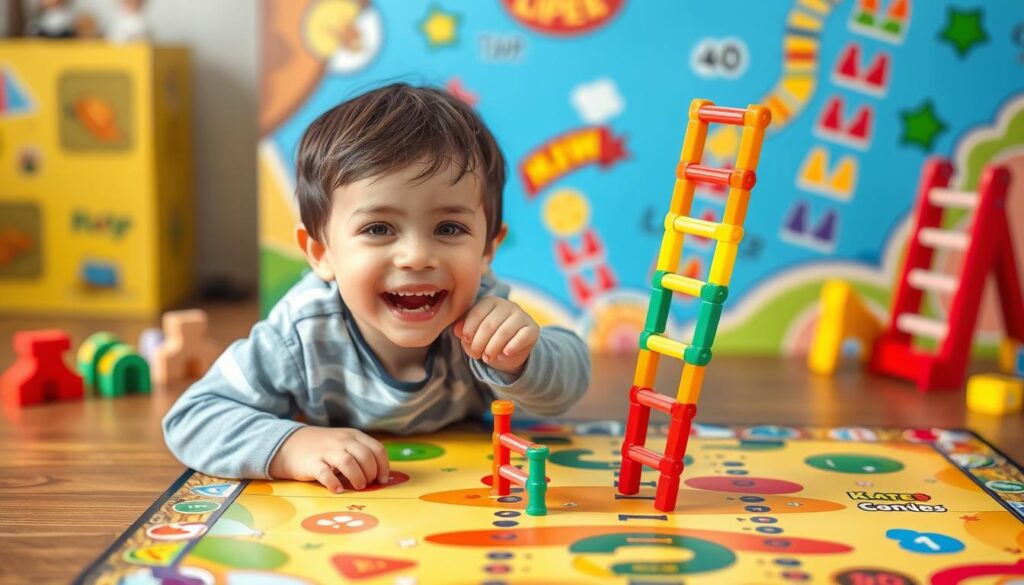
Sequence for Kids
Sequence for Kids is an excellent “bridge game” that introduces strategic thinking to 5-year-olds. Players match animal cards to corresponding spaces on the board and work to create a sequence of four chips in a row. This game teaches spatial awareness, pattern recognition, and planning ahead, all while promoting social learning through respectful competition.
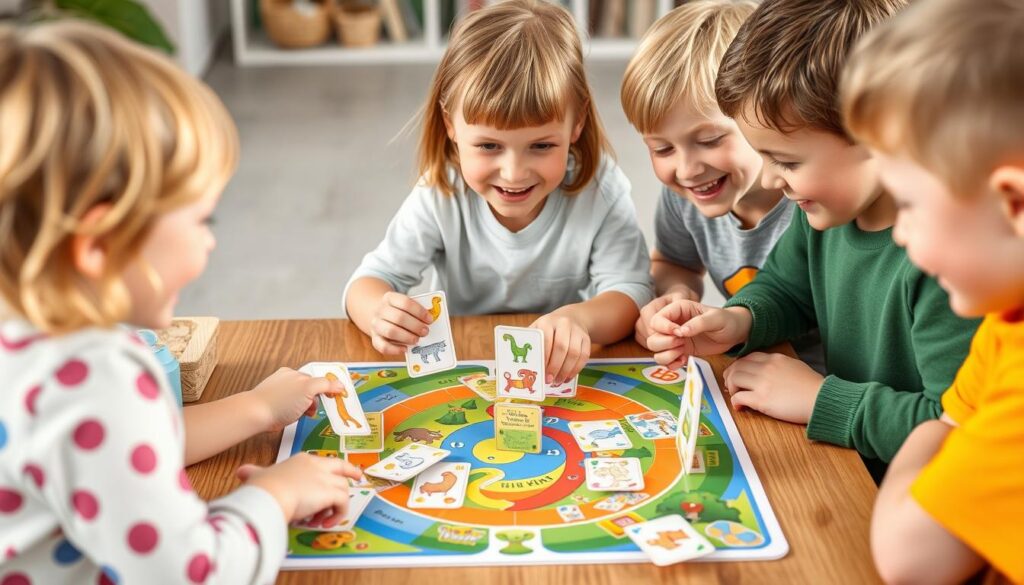
Memory and Matching Games for 5-Year-Olds
When it comes to choosing the right games for 5-year-olds, memory and matching games stand out as particularly beneficial. These games not only entertain but also significantly enhance cognitive development in young children.
Memory Matching Games
Memory matching games are an excellent way to improve memory and concentration in kids. Players take turns flipping cards to reveal hidden objects or images, trying to find matching pairs. This activity enhances visual memory and sharpens attention to detail.

Picture Bingo
Picture Bingo is a simplified version of the classic game that uses images instead of numbers, making it perfect for 5-year-olds who are still developing reading skills. Players match pictures on their cards with those called out or drawn by the game leader.
It helps develop visual discrimination, listening skills, and pattern recognition. Picture Bingo can be themed around various topics like animals, transportation, or foods to reinforce vocabulary and concept knowledge.
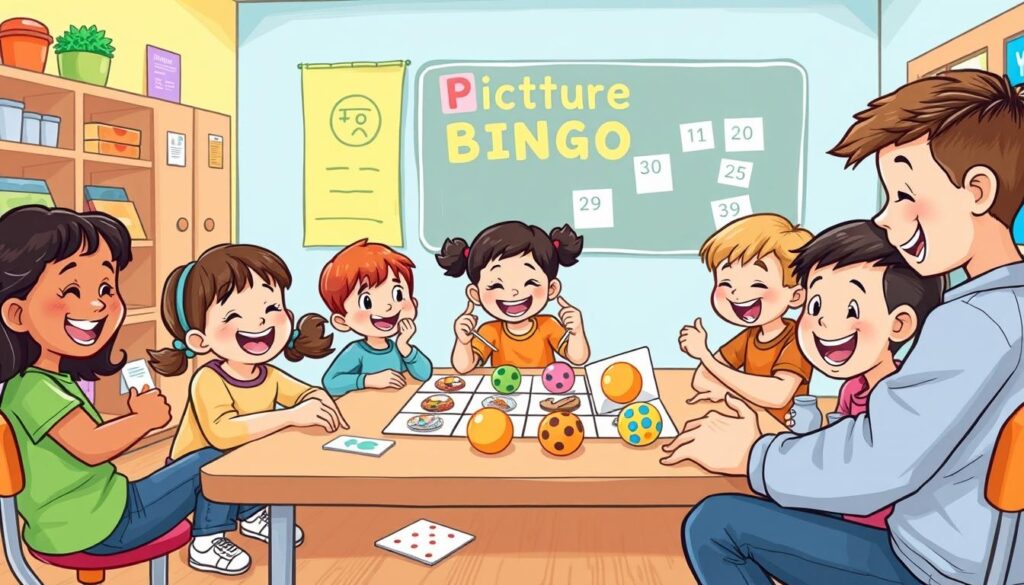
Both memory matching games and Picture Bingo offer a fun and engaging way to enhance cognitive skills in kids. By incorporating these games into their playtime, parents can provide their children with a strong foundation for future academic success.
Lunesia vs Popular Kids Games: Engagement Factor
As a parent, you’re likely wondering whether Lunesia or traditional kids’ games are more effective at capturing your child’s attention. Both types of games have their unique strengths when it comes to engaging young players.
Capturing Attention with Lunesia
Lunesia is designed to be highly engaging, using interactive digital elements to capture a child’s attention. The game’s colorful graphics and dynamic gameplay can be very appealing to young kids. By incorporating various challenges and rewards, Lunesia keeps players motivated to continue playing and improving their skills.
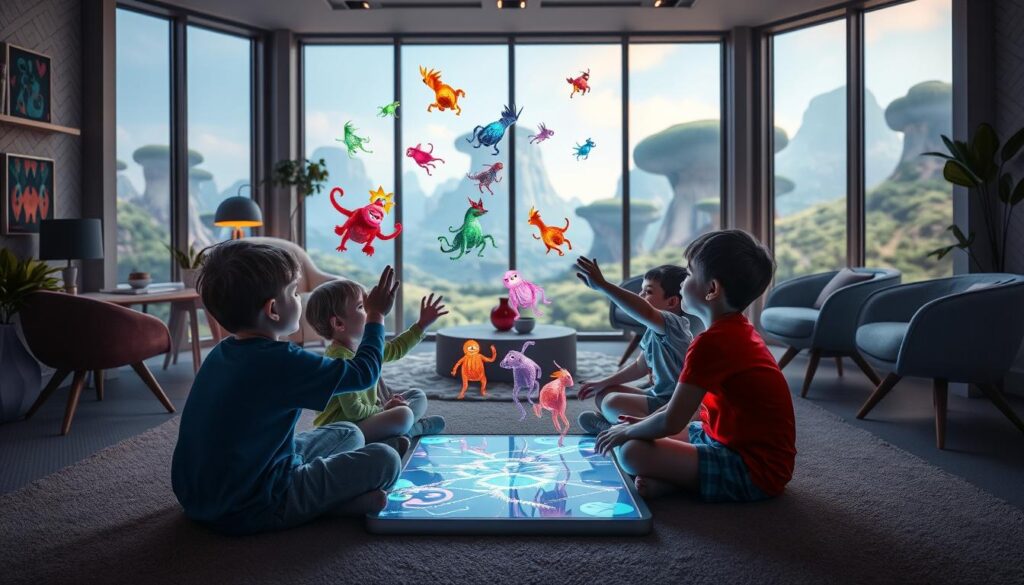
How Traditional Games Keep Kids Engaged
Traditional board games, on the other hand, offer a different kind of engagement. They keep children involved through physical interaction with game pieces, social interaction with other players, and the tactile experience of handling cards, dice, or tokens. The face-to-face nature of these games creates a social dynamic that many kids find highly engaging and motivating.
The unpredictability of human opponents in traditional games creates dynamic gameplay situations, keeping the experience fresh across multiple play sessions. Additionally, the physical presence of game components creates visual interest and tactile engagement, appealing to 5-year-olds’ sensory-focused learning style.
Comparing Learning Benefits: Lunesia vs Popular Kids Games
With so many options available, comparing the learning benefits of Lunesia and popular kids’ games is essential. As a parent, you’re not just looking for entertainment; you’re seeking tools that will help your child grow and develop essential skills.
Cognitive Skills Development
Lunesia and traditional games both offer unique cognitive benefits for kids. Lunesia, being a digital game, provides structured cognitive challenges that can enhance problem-solving skills and memory. On the other hand, traditional games like puzzles, chess, or memory matching games promote critical thinking and spatial awareness. While Lunesia offers a controlled environment with potentially consistent cognitive challenges, traditional games often require more flexible thinking and adaptation.
- Develops problem-solving skills through interactive challenges
- Enhances memory and concentration
- Promotes critical thinking and spatial awareness
Social Skills Enhancement
When it comes to social skills, traditional games have long been recognized for their ability to foster face-to-face interaction. Games like board games encourage children to take turns, read facial expressions, and handle winning and losing gracefully. Lunesia, while potentially limited in its social interaction, can still offer benefits like collaborative problem-solving. However, traditional games naturally incorporate important social skills like waiting, sharing, and helping others.
- Encourages face-to-face interaction and social cues
- Develops turn-taking and negotiation skills
- Fosters emotional regulation through winning and losing
Physical Interaction: Lunesia vs Hands-On Games
As parents, understanding how different types of games affect our children’s physical skills is essential. At 5 years old, kids are developing crucial motor skills that will impact their academic and everyday activities.
Digital vs Physical Manipulation
Traditional hands-on games involve a range of physical interactions, such as picking up small pieces, rolling dice, and moving game tokens. These actions help develop fine motor skills and hand-eye coordination. On the other hand, digital game like Lunesia offers a different kind of interaction through its touchscreen interface, requiring tapping, swiping, and dragging motions.

Fine Motor Skills Development
The physical manipulation in traditional games provides proprioceptive feedback, helping children develop muscle control and hand strength. Activities like shuffling cards or managing game pieces while moving a player token require bilateral coordination, developing important neural pathways. While Lunesia’s digital interface develops different fine motor skills, traditional games offer a unique set of physical interactions beneficial for kids.
In conclusion, both Lunesia and traditional hands-on games have their merits when it comes to physical interaction and development for 5-year-old players.
Game Complexity and Growing with Your Child
Games that evolve with your child’s age and abilities can provide years of entertainment and learning. As children grow, their cognitive and social skills develop, and games that can adapt to these changes offer the most value.
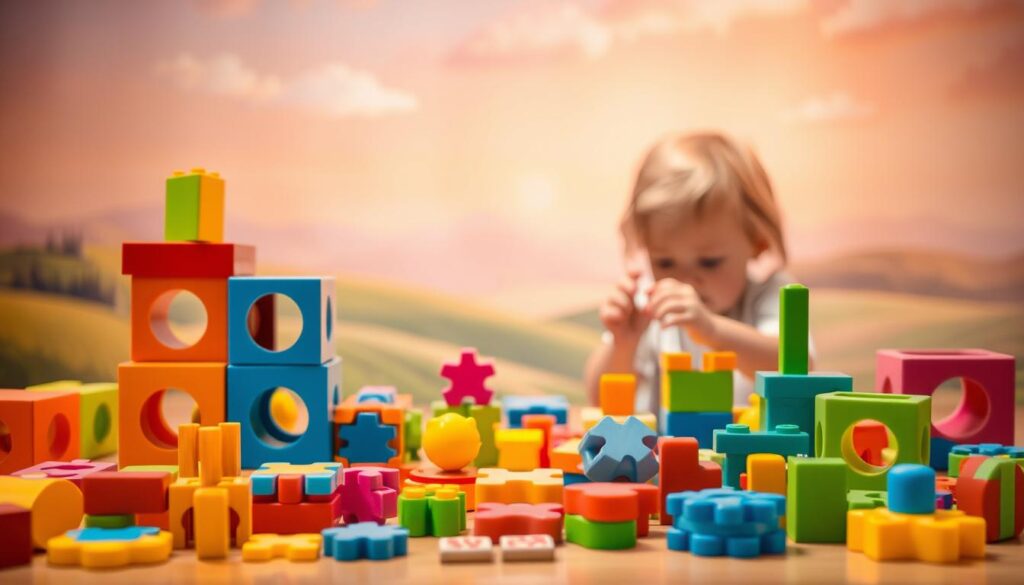
Scalability of Lunesia
Lunesia is designed to grow with your child, offering increasing complexity as their skills improve. The game’s adaptive nature ensures that it remains challenging yet engaging, providing a tailored experience for players of different ages and abilities. By adjusting its difficulty level, Lunesia keeps kids engaged over time, making it a valuable tool for learning and development.
Adaptability of Traditional Games
Traditional games can also be adapted to suit children as they grow. By modifying rules or adding new challenges, parents can extend the life of these games. For example, games like Candy Land or Memory can be made more complex by introducing additional rules or memory elements, keeping them engaging for kids across different ages. This adaptability allows families to enjoy the same games for years, adjusting them as children develop more advanced skills.
Expert Opinions on Games for 5-Year-Olds
When it comes to choosing the right games for 5-year-olds, expert opinions from pediatricians and early childhood educators can be incredibly helpful. These professionals have a deep understanding of child development and can provide valuable insights into what makes a game both fun and educational.
Pediatricians’ Recommendations
Pediatricians often recommend games that promote physical activity, social interaction, and cognitive development. They suggest games that are simple to understand but still challenging enough to keep kids engaged. For instance, games that involve following rules and taking turns can help develop social skills and emotional intelligence.
Early Childhood Educators’ Perspectives
Early childhood educators emphasize the importance of games that develop school readiness skills, such as recognizing patterns, counting, and basic literacy. They recommend games that encourage hands-on learning and creativity. According to educators, games that involve manipulatives, like puzzles and building blocks, are excellent for developing fine motor skills and problem-solving abilities.
By considering the recommendations of both pediatricians and early childhood educators, you can choose games that not only entertain your child but also support their overall development.
Parent Reviews: Lunesia vs Popular Kids Games
When it comes to selecting games for 5-year-olds, insights from fellow parents can provide valuable perspectives on what’s engaging and what’s not. Parents often share their experiences about the games their children enjoy and those that fail to capture their attention.
What Parents Say About Lunesia
Many parents appreciate Lunesia for its engaging gameplay and educational benefits. They note that it’s a great way to keep their kids occupied while also promoting learning. Some parents have mentioned that Lunesia’s interactive features make it a hit with their children, who enjoy the challenge and the rewards system. Lunesia’s ability to adapt to a child’s skill level is also praised, as it keeps the game exciting and not too frustrating.
Parent Feedback on Traditional Games
Parents often appreciate traditional games for the face-to-face interaction they provide and the break from screens. Many report that board games create valuable family bonding time and help children learn to handle winning and losing gracefully. However, some parents note that traditional games can sometimes be challenging to set up or have pieces that get lost, which can impact the frequency of play.
Despite these challenges, many parents value traditional games for their ability to bring the family together and promote social skills. They observe that games like Candy Land and Chutes and Ladders are not only fun but also help in developing cognitive skills and good sportsmanship.
Screen Time Considerations for 5-Year-Olds
Navigating the world of screen time for your 5-year-old can be challenging, but with the right guidance, you can make informed decisions. As a parent, it’s essential to strike a balance between the benefits and drawbacks of digital play.
Balancing Digital and Non-Digital Play
Finding the right balance between digital and non-digital play is crucial for your child’s overall development. While digital games like Lunesia offer educational benefits, non-digital activities promote physical exercise and social skills. I recommend setting aside dedicated time for both types of play to ensure a well-rounded experience for your child.
Co-engagement during digital play is also vital. By playing alongside your child, you can enhance the educational value of the game and help them understand the content better. This shared experience can also foster a stronger bond between you and your child.
Recommended Screen Time Limits
The American Academy of Pediatrics suggests limiting screen time to 1 hour per day of high-quality programming for children aged 2-5. While this guideline is not specifically tailored to interactive educational games, it provides a good starting point for parents. To implement screen time limits effectively, consider creating a daily routine that includes both digital and non-digital activities.
| Age Group | Recommended Screen Time Limit | Tips for Parents |
|---|---|---|
| 2-5 years | 1 hour/day | Choose high-quality, educational content and co-view with your child. |
| 6 and above | Place consistent limits | Encourage physical activity and ensure screen time doesn’t interfere with sleep. |
By being mindful of screen time and making informed choices, you can help your child develop a healthy relationship with technology.
Cost Comparison: Lunesia vs Traditional Games
As a parent, understanding the cost implications of games like Lunesia is essential. When deciding on a game for your child, you need to consider not just the initial cost but also the long-term value it provides.
Initial Investment
The initial investment in a game can vary significantly between digital and traditional options. Lunesia, being a digital game, might require a one-time purchase or subscription. In contrast, traditional board games have a clear upfront cost. For example, popular kids’ board games can range from $20 to $50. It’s essential to compare these initial costs when deciding between Lunesia and traditional games.
- Lunesia: One-time purchase or subscription model
- Traditional board games: Clear upfront cost, ranging from $20 to $50
Long-Term Value
When it comes to long-term value, traditional board games often have an edge as they can be used for years and passed down to younger siblings. Digital games like Lunesia may offer updates or expandable content, but their lifespan can be limited by technological advancements or changes in company support.
- Traditional games: Durable, can be passed down, and have resale or donation potential
- Lunesia: May offer updates, but tied to current technology
Accessibility and Ease of Learning
For a game to be truly engaging for 5-year-olds, it must be both accessible and easy to learn. This is where both Lunesia and traditional games have their strengths and weaknesses.
Learning Curve for Lunesia
Lunesia is designed with young players in mind, featuring an intuitive interface that allows children to navigate the game with ease. The game’s rules are introduced gradually, allowing kids to learn at their own pace. As a parent, you can feel confident that your child is not only having fun but also developing essential skills.
The digital nature of Lunesia means that the game itself guides the player through the initial stages, reducing the need for adult intervention. This can be particularly beneficial for children who are just starting to learn how to play games.
Getting Started with Traditional Games
Traditional games for 5-year-olds typically have simple rules that can be learned quickly. Many of these games are designed to be explained in just a few minutes, allowing children to start playing with minimal instruction. As a parent, you’ll need to provide guidance during the first few play sessions until your child internalizes the rules.
One of the benefits of traditional games is that they often cater to different learning styles. For example, picture-based games are great for visual learners, while games with physical pieces can help kinesthetic learners. By starting with simple rules and gradually adding complexity, you can help your child master the game.
Creative Games That Rival Both Options
When it comes to engaging 5-year-olds, there’s a whole world of creative games beyond Lunesia and popular kids’ games. These alternatives can offer a fresh and exciting way to play, fostering development and fun.
DIY Games for 5-Year-Olds
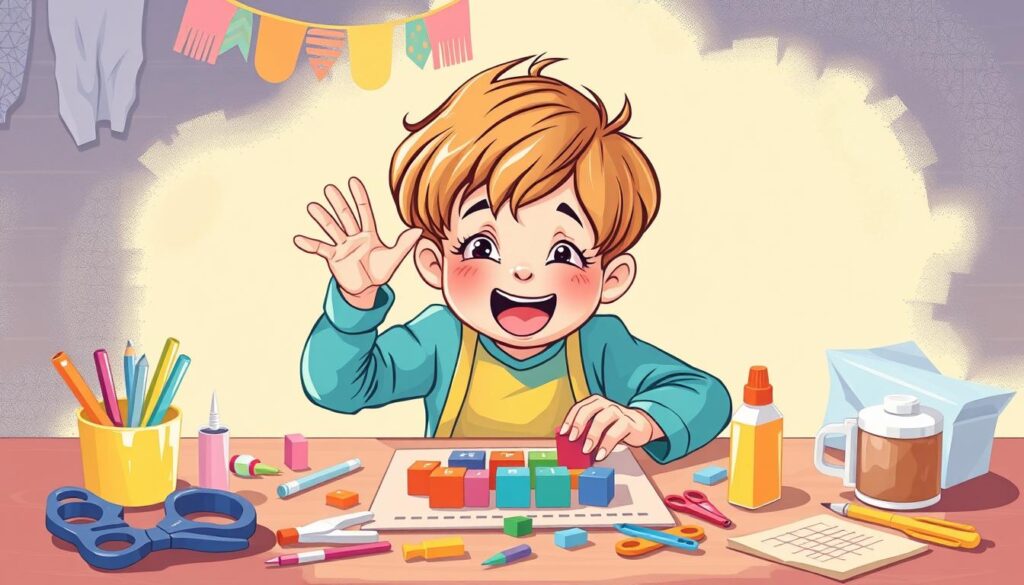
DIY games are an excellent way to engage 5-year-olds, encouraging creativity and imagination. You can create simple games like a memory match using everyday objects or make a mini obstacle course using household items.
Outdoor Games That Engage 5-Year-Olds

Outdoor games like hopscotch, simple tag variations, and “Red Light, Green Light” are perfect for 5-year-olds. These games combine physical activity with simple rules, helping develop gross motor skills, following directions, and social interaction in a natural environment.
Outdoor games naturally incorporate physical activity, addressing 5-year-olds’ high energy levels and need for movement. They also develop a unique combination of physical, cognitive, and social skills simultaneously, creating rich developmental opportunities through play.
Making the Right Choice for Your 5-Year-Old
The ideal game for your 5-year-old depends on several factors, including their interests and learning style. As a parent, you’re in the best position to observe your child’s engagement and determine which games truly capture their attention.
Many experts recommend offering a variety of game experiences, including both digital and traditional options, to support well-rounded development. This approach allows your child to benefit from different formats, such as Lunesia and traditional games, each offering unique advantages.
When evaluating games, consider your child’s attention span, preferred play styles, and the specific skills they’re working to develop. By doing so, you can make informed decisions that cater to their needs. Remember, the goal is to create a positive family experience that fosters a healthy relationship with both technology and traditional play.
Ultimately, the “right” choice isn’t universal; it’s about finding the best fit for your child and making time for fun, engaging activities that promote development. By being involved and observant, you can ensure that the games you choose, whether digital or traditional, or games like Lunesia, contribute to a nurturing environment for your kids to thrive.
FAQ
What are the benefits of playing board games for children?
Playing board games helps children develop important skills like problem-solving, critical thinking, and social interaction. It also enhances their fine motor skills and hand-eye coordination.
How do I choose the right game for my child?
Consider your child’s age, interests, and abilities when selecting a game. Opt for games that are both fun and challenging, yet not too complex.
Are digital games like Lunesia as effective as traditional board games?
Both digital and traditional games have their own benefits. Digital games like Lunesia can offer interactive and engaging experiences, while traditional board games promote social interaction and physical activity.
How can I ensure my child is not spending too much time playing digital games?
Set screen time limits and encourage a balance between digital and non-digital play. You can also explore alternative games that promote physical activity and social interaction.
What are some popular board games suitable for 5-year-olds?
Some popular options include Candy Land, Chutes and Ladders, and Sequence for Kids. These games are designed to be fun and easy to understand for young children.
Can games like Lunesia help improve my child’s cognitive skills?
Yes, games like Lunesia are designed to enhance cognitive skills such as memory, problem-solving, and critical thinking. They can be a valuable addition to your child’s play routine.
![Lunesia vs [Kids Game] 5 year old](https://lunesia.app/wp-content/uploads/2025/06/Lunesia-vs-Kids-Game-5-year-old-1024x585.jpeg)
